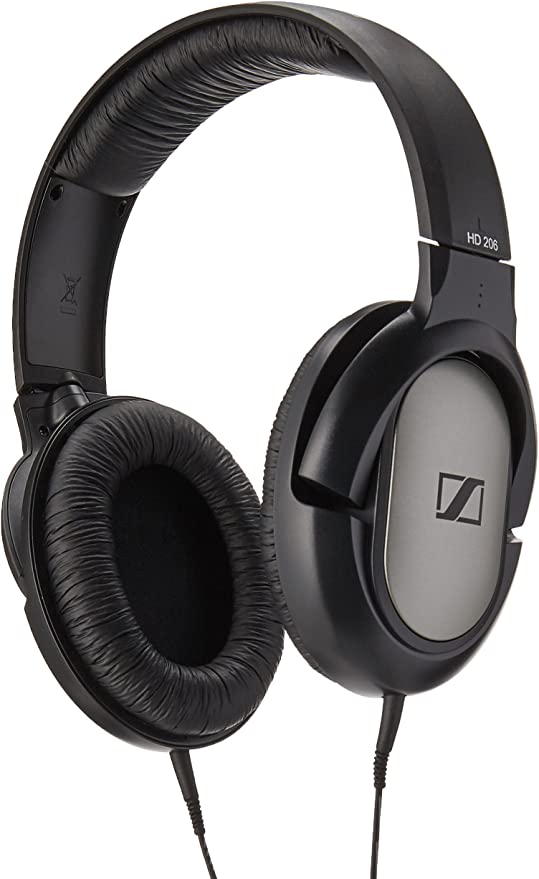Imagine this: you’re trying to lose yourself in your favorite album, but the chatter from the next room keeps pulling you back. Or perhaps you’re laying down a vocal track in your home studio, striving for that perfect take, only to find the click track bleeding from your headphones into the microphone. In countless moments, our desire for clear, focused sound clashes with the noisy reality of the world around us or the technical demands of creation. How do we carve out our own pocket of sound without breaking the bank? Sometimes, the most elegant solutions lie not in complex technologies, but in the clever application of fundamental principles – principles embodied in accessible gear like the Sennheiser HD 206 Closed-Back Over Ear Headphones.
While the world of audio technology constantly pushes boundaries with intricate digital processing and wireless innovations, there’s enduring value in understanding the bedrock science that makes listening possible. Sennheiser, a name synonymous with audio innovation since its founding in post-WWII Germany by Prof. Dr. Fritz Sennheiser, built its legacy on precisely this: a deep understanding of acoustics and electronics. Though perhaps best known for pioneering microphones and high-fidelity headphones like the iconic open-back HD 414, their more accessible offerings, like the HD 206, serve as practical examples of core engineering concepts at work. Let’s peel back the layers and explore the science that makes these seemingly simple headphones tick.

The Physics of the Sealed Chamber: Closed-Back Acoustics
The first thing you’ll likely notice about the HD 206 is its earcups – they are solid, with no visible vents or grills on the outside. This defines them as “closed-back” headphones, and this deliberate design choice has significant acoustic consequences, rooted in basic physics.
Think of each earcup as a small, sealed room for your ear. Just as closing the windows and doors of a room significantly reduces the amount of noise coming in from the outside street, the sealed nature of the HD 206’s earcups, combined with the over-ear pads that form a snug fit around your ears, creates a physical barrier against ambient sound waves. This effect is known as Passive Noise Isolation. It doesn’t rely on sophisticated electronics to cancel noise; rather, it uses the physical properties of materials and the sealed volume of air to dampen external sounds, particularly in the mid and high frequencies – the range where human voices and many distracting environmental noises reside. The result? The external world fades back, allowing you to focus more intently on the audio playing inside the headphones.
But the sealed chamber works in two directions. It not only keeps external noise out, but it also keeps the sound generated by the headphones in. This phenomenon, or rather the lack of leakage, is crucial in recording scenarios. Imagine a vocalist trying to record. They need to hear the backing track or click track in their headphones, but if that sound leaks out and is picked up by the highly sensitive microphone capturing their voice, the recording will be compromised. It’s like trying to have a private conversation in a library – whispers can carry. Closed-back headphones act like a well-insulated practice room, minimizing this sound bleed and helping to ensure a cleaner, more professional recording, even in a modest home studio setup.
It’s worth noting, as a general principle of acoustics, that this focus and isolation offered by closed-back designs often comes with a subtle trade-off. Compared to their “open-back” cousins (which allow air and sound to pass freely through the earcups), closed-back headphones can sometimes present a soundstage that feels more intimate or “in-the-head,” rather than wide and expansive. This isn’t necessarily a flaw, but rather a characteristic inherent to the design choice, prioritizing isolation over ambient openness.

The Heartbeat of Sound: Dynamic Drivers Explained
So, the earcups create a controlled acoustic environment. But how is the sound itself actually produced? Inside each earcup of the HD 206 lies the engine of the headphone: a dynamic driver. While various driver technologies exist (planar magnetic, electrostatic, etc.), the dynamic driver remains the most common type found in headphones across all price ranges, celebrated for its reliability, cost-effectiveness, and ability to produce a full range of sound.
Think of a dynamic driver as a miniature version of the traditional loudspeakers you might have in your living room. Its operation relies on a fundamental principle of electromagnetism. Here’s a simplified breakdown:
- The Signal: Your phone, computer, or audio player sends an electrical audio signal down the headphone cable. This signal is essentially a fluctuating electrical current that mirrors the shape of the sound wave.
- The Voice Coil: This electrical signal flows through a very fine coil of wire (the voice coil) which is attached to a cone- or dome-shaped membrane called the diaphragm.
- The Magnet: A permanent magnet is positioned strategically near the voice coil.
- The Interaction: As the electrical audio signal fluctuates through the voice coil, it creates a changing magnetic field around the coil. This magnetic field interacts with the field of the permanent magnet, causing the voice coil (and the attached diaphragm) to rapidly move back and forth, following the pattern of the original electrical signal.
- The Sound Wave: The rapid vibration of the diaphragm pushes and pulls the air in front of it, creating pressure waves – sound waves – that travel through the small volume of air in the earcup and ultimately reach your eardrum, which your brain interprets as sound.
It’s a beautifully simple yet effective mechanism, transforming electrical energy back into the acoustic energy we perceive as music, voice, or sound effects. The “dynamic audio with crisp bass” mentioned in the HD 206’s description points to the capabilities of these drivers to reproduce the varying intensities and frequencies inherent in recorded sound.
The Electrical Language: Impedance and Wired Reliability
For the dynamic drivers to do their work, they need to receive that electrical audio signal clearly and efficiently. This brings us to two other key specifications: impedance and the wired connection.
The HD 206 has a specified impedance of 24 Ohms (\Omega). What exactly is impedance in this context? In layman’s terms, it’s a measure of how much the headphone “resists” the flow of the electrical audio signal from the source device. Think of it like the width of a water pipe: a wider pipe (lower resistance/impedance) allows water (the audio signal) to flow more easily with less pressure (voltage), while a narrower pipe (higher resistance/impedance) requires more pressure to achieve the same flow rate.
At 24 \Omega, the HD 206 falls squarely into the low impedance category for headphones. This is significant because it means they don’t require a lot of power (voltage) from the audio source to reach satisfying volume levels. High impedance headphones, sometimes exceeding 300 \Omega or even 600 \Omega (often favored in specific high-end audio or studio applications for potential technical benefits like driver control), typically necessitate a dedicated headphone amplifier to provide enough power for them to sound their best.
The practical benefit of the HD 206’s low impedance is its universal compatibility. It can be easily driven by the standard headphone outputs found on virtually all consumer electronics – smartphones, laptops, tablets, portable music players – without needing any extra hardware. This plug-and-play simplicity makes them incredibly versatile for everyday use across a multitude of devices, aligning with the manufacturer’s claim of compatibility with everything from cell phones to studio recorders (at least those with standard headphone outputs).
Furthermore, the HD 206 relies on a traditional wired connection using a standard 1/8 inch (3.5mm) plug, with an included 1/4 inch (6.3mm) adapter. In an increasingly wireless world, the humble cable still holds distinct advantages, particularly for audio fidelity and critical applications. A wire transmits the analog audio signal directly, without the potential for digital compression artifacts that can occur with some Bluetooth codecs, and completely avoids the latency (delay) inherent in wireless transmission – crucial for recording or DJing where timing is everything. Plus, wired headphones never need charging. It’s a testament to reliable, straightforward signal delivery.
Bringing it Together: Design, Comfort, and Application
Science and specifications are fascinating, but how do they translate into real-world experience? The HD 206 integrates these principles into a functional package. Its claimed lightweight design (around 6.1 ounces or 173 grams) directly addresses user comfort, a critical factor during the long listening sessions, studio work, or DJ practice sets mentioned in its description. Basic ergonomics dictates that reducing the mass worn on the head significantly minimizes fatigue over time.
The inclusion of the 1/4 inch (6.3mm) adapter is a small but thoughtful touch. While the 3.5mm plug handles consumer devices, the larger 6.3mm jack is common on audio interfaces, mixing consoles, dedicated headphone amplifiers, and some musical instruments. This adapter instantly broadens the HD 206’s utility, allowing it to bridge the gap between casual listening and more serious audio work or practice.
Now, let’s paint a few pictures of the HD 206 in action, leveraging the science we’ve discussed:
- The Home Studio Musician: Needs to monitor their performance accurately while recording vocals or instruments. The closed-back design minimizes sound bleed into the microphone, while the low impedance ensures they work easily with the headphone output of an audio interface or computer.
- The Student or Remote Worker: Trying to concentrate in a noisy dorm room or shared living space. The passive noise isolation helps reduce distractions, creating a more focused environment for studying or attending online meetings.
- The Aspiring DJ: Practicing beatmatching and mixing. The closed-back isolation helps them hear the cue track clearly over ambient noise or booth monitors, while the wired connection ensures zero latency for precise timing.
- The Commuter or Traveler: Seeking some respite from the rumble of a train or the drone of a plane. While passive isolation has limits, especially with low-frequency noise, the closed-back design can still offer a noticeable reduction in ambient sound compared to open or on-ear types.

Concluding Thoughts: The Enduring Value of Fundamentals
The Sennheiser HD 206 serves as a compelling reminder that effective audio reproduction doesn’t always require the latest, most complex technology. By skillfully applying fundamental principles – the acoustic isolation of a sealed chamber, the electromechanical efficiency of dynamic drivers, and the straightforward compatibility offered by low impedance and a wired connection – it delivers a reliable and functional listening tool.
In a world often dazzled by feature lists and marketing buzzwords, there’s a quiet confidence in gear that simply gets the basics right. The HD 206 embodies a philosophy where solid engineering and an understanding of core audio science provide accessible performance. It might not have active noise cancellation or wireless convenience, but it offers focused sound, broad compatibility, and the reliability needed for both enjoyment and creation. Understanding the ‘why’ behind its design not only helps appreciate this particular headphone but also enriches our broader understanding and appreciation of the fascinating science that brings sound to our ears.




